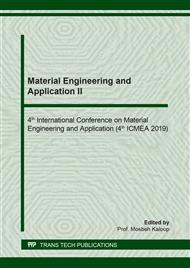[1]
T. W. Sun et al., Ultralong hydroxyapatite nanowires/collagen scaffolds with hierarchical porous structure, enhanced mechanical properties and excellent cellular attachment, Ceram. Int. 43(17) (2017) 15747-15754.
DOI: 10.1016/j.ceramint.2017.08.137
Google Scholar
[2]
M. Ai, et al. Composite resin reinforced with silver nanoparticles–laden hydroxyapatite nanowires for dental application, Dent. Mater. 33(1) (2017) 12-22.
DOI: 10.1016/j.dental.2016.09.038
Google Scholar
[3]
J. He, et al. Performance of novel hydroxyapatite nanowires in treatment of fluoride contaminated water, J. Hazard. Mater. 303 (2016) 119-130.
Google Scholar
[4]
Y. D. Yu, Y. J. Zhu, C. Qi, Y. Y. Jiang, H. Li, J. Wu, Hydroxyapatite nanorod-assembled porous hollow polyhedra as drug/protein carriers, J. Colloid Interface Sci. 496 (2017) 416-424.
DOI: 10.1016/j.jcis.2017.02.041
Google Scholar
[5]
H. Yang, et al. Solvothermal synthesis of hydroxyapatite nanorods with assistance of green polymer, Mater. Sci. Eng. C, 79 (2017) 9-14.
Google Scholar
[6]
D. N. Thanh, P. Novák, J. Vejpravova, H. N. Vu, J. Lederer, T. Munshi, Removal of copper and nickel from water using nanocomposite of magnetic hydroxyapatite nanorods, J. Magn. Magn. Mater. 456 (2018) 451-460.
DOI: 10.1016/j.jmmm.2017.11.064
Google Scholar
[7]
H. Wang, et al. The hydroxyapatite nanotube as a promoter to optimize the HDS reaction of NiMo/TiO2catalyst, Catal. Today, 259 (2016) 340-346.
DOI: 10.1016/j.cattod.2015.06.005
Google Scholar
[8]
Q. Sun, J. T. Lou, F. Kang, J. F. Chen, J. X. Wang, Facile preparation of hydroxyapatite nanotubes assisted by needle-like calcium carbonate, Powder Technol. 261 (2014) 49-54.
DOI: 10.1016/j.powtec.2014.04.014
Google Scholar
[9]
B. B. Chandanshive, P. Rai, A. L. Rossi, O. Ersen, D. Khushalani, Synthesis of hydroxyapatite nanotubes for biomedical applications, Mater. Sci. Eng. C, 33(5) (2013) 2981-2986.
DOI: 10.1016/j.msec.2013.03.022
Google Scholar
[10]
B. Matovic, M. P. Djordjevic, J. Maletaskic, K. Yoshida, T. Yano, Preparation and properties of hydroxyapatite nano-spheres for immobilization of Sr isotopes, Energy Procedia, 131 (2017)140-145.
DOI: 10.1016/j.egypro.2017.09.419
Google Scholar
[11]
H. H. Abo-Almaged, A. A. Gaber, Synthesis and characterization of nano-hydroxyapatite membranes for water desalination, Mater. Today Commun. 13 (2017) 186-191.
DOI: 10.1016/j.mtcomm.2017.10.002
Google Scholar
[12]
S. Zhong, et al. Effects for rapid conversion from abalone shell to hydroxyapaptite nanosheets by ionic surfactants, Mater. Sci. Eng. C, 77 (2017) 708-712.
DOI: 10.1016/j.msec.2017.04.009
Google Scholar
[13]
I. S. Yahia, M. Shkir, S. AlFaify, V. Ganesh, H. Y. Zahran, M. Kilany, Facile microwave-assisted synthesis of Te-doped hydroxyapatite nanorods and nanosheets and their characterizations for bone cement applications, Mater. Sci. Eng. C, 72 (2017) 472-480.
DOI: 10.1016/j.msec.2016.11.074
Google Scholar
[14]
X. Y. Zhao, et al. Hydroxyapatite nanosheet-assembled microspheres: Hemoglobin-templated synthesis and adsorption for heavy metal ions, J. Colloid Interface Sci. 416 (2014) 11-18.
DOI: 10.1016/j.jcis.2013.10.034
Google Scholar
[15]
C. Qi, Y.-J. Zhu, B.-Q. Lu, X.-Y. Zhao, J. Zhao, F. Chen, Hydroxyapatite nanosheet-assembled porous hollow microspheres: DNA-templated hydrothermal synthesis, drug delivery and protein adsorption, J. Mater. Chem. 22(42) (2012) 22642.
DOI: 10.1039/c2jm35280j
Google Scholar
[16]
X.-Y. Zhao, Y.-J. Zhu, F. Chen, B.-Q. Lu, J. Wu, Nanosheet-assembled hierarchical nanostructures of hydroxyapatite: surfactant-free microwave-hydrothermal rapid synthesis, protein/DNA adsorption and pH-controlled release, Cryst. Eng. Comm. 15(1) (2013) 206-212.
DOI: 10.1039/c2ce26315g
Google Scholar
[17]
M. M. Taheri, et al. Surfactant-assisted hydrothermal synthesis of Fluoridated Hydroxyapatite nanorods, Ceram. Int. 41(8) (2015) 9867-9872.
DOI: 10.1016/j.ceramint.2015.04.061
Google Scholar
[18]
P. Shi, et al. Hydroxyapatite nanorod and microsphere functionalized with bioactive lactoferrin as a new biomaterial for enhancement bone regeneration, Colloids Surfaces B Biointerfaces, 155 (2017) 477-486.
DOI: 10.1016/j.colsurfb.2017.04.042
Google Scholar
[19]
P. Kubasiewicz-Ross, et al. New nano-hydroxyapatite in bone defect regeneration: A histological study in rats, Ann. Anat. 213 (2017) 83-90.
DOI: 10.1016/j.aanat.2017.05.010
Google Scholar
[20]
M. N. Hassan, M. M. Mahmoud, A. A. El-Fattah, S. Kandil, Microwave-assisted preparation of Nano-hydroxyapatite for bone substitutes, Ceram. Int. 42(3) (2016) 3725-3744.
DOI: 10.1016/j.ceramint.2015.11.044
Google Scholar
[21]
A. Szcześ, L. Hołysz, E. Chibowski, Synthesis of hydroxyapatite for biomedical applications, Adv. Colloid Interface Sci. 249 (2017) 321-330.
DOI: 10.1016/j.cis.2017.04.007
Google Scholar
[22]
E. J. M. Edralin, J. L. Garcia, F. M. dela Rosa, E. R. Punzalan, Sonochemical synthesis, characterization and photocatalytic properties of hydroxyapatite nano-rods derived from mussel shells, Mater. Lett. 196 (2017) 33-36.
DOI: 10.1016/j.matlet.2017.03.016
Google Scholar
[23]
N. Liu, et al. Nano-hydroxyapatite as an Efficient Polysulfide Absorbent for High-performance Li-S Batteries, Electrochim. Acta, 215 (2016) 162-170.
DOI: 10.1016/j.electacta.2016.08.083
Google Scholar
[24]
L. Pei, T. Tsuzuki, A. Dodd, M. Saunders, Synthesis of calcium chlorapatite nanoparticles and nanorods via a mechanically-induced solid-state displacement reaction and subsequent heat treatment, Ceram. Int. 43(14) (2017) 11410-11414.
DOI: 10.1016/j.ceramint.2017.05.350
Google Scholar
[25]
D. Mehta, P. Mondal, V. K. Saharan, S. George, Synthesis of hydroxyapatite nanorods for application in water defluoridation and optimization of process variables: Advantage of ultrasonication with precipitation method over conventional method, Ultrason. Sonochem. 37 (2017) 56-70.
DOI: 10.1016/j.ultsonch.2016.12.035
Google Scholar
[26]
M. Chahkandi, Mechanism of Congo red adsorption on new sol-gel-derived hydroxyapatite nano-particle, Mater. Chem. Phys. 202 (2017) 340-351.
DOI: 10.1016/j.matchemphys.2017.09.047
Google Scholar
[27]
S. Akter Jahan, M. Y. A. Mollah, S. Ahmed, M. Abu Bin Hasan Susan, Nano-Hydroxyapatite Prepared from Eggshell-Derived Calcium-Precursor using Reverse Microemulsions as Nanoreactor, Mater. Today Proc. 4(4) (2017) 5497-5506.
DOI: 10.1016/j.matpr.2017.06.005
Google Scholar
[28]
J. S. Cho, S. H. Rhee, Formation mechanism of nano-sized hydroxyapatite powders through spray pyrolysis of a calcium phosphate solution containing polyethylene glycol, J. Eur. Ceram. Soc. 33(2) (2013) 233-241.
DOI: 10.1016/j.jeurceramsoc.2012.08.029
Google Scholar
[29]
S. K. Ghosh, S. K. Roy, B. Kundu, S. Datta, D. Basu, Synthesis of nano-sized hydroxyapatite powders through solution combustion route under different reaction conditions, Mater. Sci. Eng. B Solid-State Mater. Adv. Technol. 176(1) (2011) 14-21.
DOI: 10.1016/j.mseb.2010.08.006
Google Scholar
[30]
A. Nur, H. Setyawan, A. Widjaja, I. W. Lenggoro, Electrochemical processes for the formation of hydroxyapatite powders, Bull. Chem. React. Eng. Catal. 9(3) (2014) 168-174.
DOI: 10.9767/bcrec.9.3.6686.168-174
Google Scholar
[31]
A. Nur, H. Setyawan, An experimental and theoretical investigation of the formation of hydroxyapatite particles prepared by an electrochemical method, J. Chem. Eng. Japan, 49(2) (2016) 144-151.
DOI: 10.1252/jcej.15we130
Google Scholar


